Informed Finite Element Modelling for Wire and Arc Additively Manufactured Metallics—A Case Study on Modular Building Connections
Abstract
:1. Introduction
2. Background
2.1. Modular Buildings and Inter-Modular Connections
2.2. Metal 3D Printing and Limitations of WAAM
3. Finite Element (FE) Modelling of Modular Connections
3.1. General
3.2. FE Mesh
3.3. Material Model
3.4. Contact Interactions
3.5. Loading and Boundary Conditions
3.6. Analysis
3.7. Validation of the Model
4. FE Modelling of WAAM Stainless Steel Behaviour
4.1. Model Development
4.2. Validation
5. Assessment of the 3D Printed Stainless Steel Modular Connection
5.1. General
5.2. Results and Discussion
5.2.1. 3D Printed Connection with Untreated WAAM Surfaces and Equivalent Thickness Approach
5.2.2. 3D Printed Connection with Treated WAAM Surfaces
5.3. Recommendations for FE Modelling and Design of 3DMBCs
- Components such as cover plates and stiffeners, which are relatively thicker and smaller in size, can be 3D printed without altering the performance of the modular connections. Alternatively, if not required, these components should not be 3D printed due to the increase in the total cost of the connection’s manufacture.
- Increasing the thickness of beams and columns of the fully 3D printed connection is recommended to achieve the same level of strength as the normal connection.
- Untreated or treated WAAM material properties corresponding to θ = 90° orientation can be used in the FE modelling of 3DMBCs to obtain conservative results.
6. Concluding Remarks
- The effect of a 3D printed connection on structural response is negligible compared to the conventional modular steel connection when replacing selected 3D printed structural components that are not highly responsible for the behaviour of modular connections.
- A significant reduction in the structural performance, such as load-bearing capacity and initial stiffness, was identified when the entire modular connection was 3D printed using the WAAM method.
- In an attempt to calculate the equivalent WAAM thickness that offers similar structural performance to that of the traditional steel modular connections, the untreated thickness of the columns and beams in the connection was increased from 8 mm to 12 mm (50% increment of the thickness).
- A 3D printed modular connection with θ = 45° print orientation showed identical structural behaviour compared to the reference modular connection, though the 3D printed modular connections with θ = 0° and θ = 90° print orientation resulted in relatively lower performance compared to the reference modular connection.
- However, due to the practical limitations of producing the connections with θ = 45° print orientation, it is suggested to consider the material properties of treated WAAM products obtained in θ = 90° print orientation to examine the structural performance through numerical modelling.
Author Contributions
Funding
Institutional Review Board Statement
Informed Consent Statement
Data Availability Statement
Acknowledgments
Conflicts of Interest
References
- Peng, J.; Hou, C.; Shen, L. Lateral resistance of multi-story modular buildings using tenon-connected inter-module connections. J. Constr. Steel Res. 2021, 177, 106453. [Google Scholar] [CrossRef]
- Ye, Z.; Giriunas, K.; Sezen, H.; Wu, G.; Feng, D.-C. State-of-the-art review and investigation of structural stability in multi-story modular buildings. J. Build. Eng. 2021, 33, 101844. [Google Scholar] [CrossRef]
- Lacey, A.W.; Chen, W.; Hao, H.; Bi, K. Lateral behaviour of modular steel building with simplified models of new inter-module connections. Eng. Struct. 2021, 236, 112103. [Google Scholar] [CrossRef]
- Dai, Z.; Cheong, T.Y.C.; Pang, S.D.; Liew, J.Y.R. Experimental study of grouted sleeve connections under bending for steel modular buildings. Eng. Struct. 2021, 243, 112614. [Google Scholar] [CrossRef]
- Zhao, F.; Yu, Y.; Lin, S.; Ding, F. Evaluation of the working mechanisms and simplified models of endplate-type inter-module connections. Structures 2021, 32, 562–577. [Google Scholar] [CrossRef]
- Park, K.-S.; Moon, J.; Lee, S.-S.; Bae, K.-W.; Roeder, C.W. Embedded steel column-to-foundation connection for a modular structural system. Eng. Struct. 2016, 110, 244–257. [Google Scholar] [CrossRef]
- Lacey, A.W.; Chen, W.; Hao, H.; Bi, K. New interlocking inter-module connection for modular steel buildings: Simplified structural behaviours. Eng. Struct. 2021, 227, 111409. [Google Scholar] [CrossRef]
- Sendanayake, S.V.; Thambiratnam, D.P.; Perera, N.J.; Chan, T.H.T.; Aghdamy, S. Enhancing the lateral performance of modular buildings through innovative inter-modular connections. Structures 2021, 29, 167–184. [Google Scholar] [CrossRef]
- Allen, S.M.; Sachs, E.M. Three-dimensional printing of metal parts for tooling and other applications. Met. Mater. 2000, 6, 589–594. [Google Scholar] [CrossRef]
- Ashraf, M.; Gibson, I.; Rashed, M.G. Challenges and prospects of 3D printing in structural engineering. In Proceedings of the 13th International Conference on Steel, Space and Composite Structures, Perth, WA, Australia, 11 February 2018. [Google Scholar]
- Buchanan, C.; Matilainen, V.-P.; Salminen, A.; Gardner, L. Structural performance of additive manufactured metallic material and cross-sections. J. Constr. Steel Res. 2017, 136, 35–48. [Google Scholar] [CrossRef]
- Buchanan, C.; Gardner, L. Metal 3D printing in construction: A review of methods, research, applications, opportunities and challenges. Eng. Struct. 2019, 180, 332–348. [Google Scholar] [CrossRef]
- Galjaard, S.; Hofman, S.; Perry, N.; Ren, S. Optimizing structural building elements in metal by using additive manufacturing. In Proceedings of the IASS Annual Symposia, International Association for Shell and Spatial Structures (IASS), Amsterdam, The Netherlands, 2 August 2015; pp. 1–12. [Google Scholar]
- Pires, M.M. Finite Element Analysis of Residual Stresses in Metallic Parts Produced Byadditive Manufacturing. Master’s Thesis, University of Porto, Porto, Portugal, 2021. [Google Scholar]
- van Bolderen, G. Exploration of Stability of 3D-Printed Steel Members: A Study to Buckling Behaviour of Wire and Arc Additively Manufactured Stainless Steel Tubular Columns. Master’s Thesis, Delft University of Technology, Delft, The Netherlands, 2017. [Google Scholar]
- Laghi, V.; Palermo, M.; Gasparini, G.; Girelli, V.A.; Trombetti, T. Experimental results for structural design of Wire-and-Arc Additive Manufactured stainless steel members. J. Constr. Steel. Res. 2020, 167, 105858. [Google Scholar] [CrossRef]
- Gardner, L.; Kyvelou, P.; Herbert, G.; Buchanan, C. Testing and initial verification of the world’s first metal 3D printed bridge. J. Constr. Steel Res. 2020, 172, 106233. [Google Scholar] [CrossRef]
- Al-Nabulsi, Z.; Mottram, J.T.; Gillie, M.; Kourra, N.; Williams, M.A. Mechanical and X ray computed tomography characterisation of a WAAM 3D printed steel plate for structural engineering applications. Constr. Build. Mater. 2021, 274, 121700. [Google Scholar] [CrossRef]
- Kyvelou, P.; Slack, H.; Daskalaki Mountanou, D.; Wadee, M.A.; Britton, T.B.; Buchanan, C.; Gardner, L. Mechanical and microstructural testing of wire and arc additively manufactured sheet material. Mater. Des. 2020, 192, 108675. [Google Scholar] [CrossRef]
- Camacho, D.D.; Clayton, P.; O’Brien, W.J.; Jung, K.Y. 3D Printed Fastener-Free Connections for Non-Structural and Structural Applications–An Exploratory Investigation. In International Solid Freeform Fabrication Symposium; University of Texas: Austin, TX, USA, 2018. [Google Scholar]
- Lange, J.; Feucht, T.; Erven, M. 3D printing with steel. Steel Constr. 2020, 13, 144–153. [Google Scholar] [CrossRef]
- Lange, J.; Feucht, T. 3-D-Printing with Steel: Additive Manufacturing of Connection Elements and Beam Reinforcements. In Proceedings of the IABSE Symposium, Guimarães 2019: Towards a Resilient Built Environment Risk and Asset Management, Guimarães, Portugal, 27–29 March 2019; pp. 1836–1841. [Google Scholar]
- Khosravani, M.R.; Reinicke, T. Effects of raster layup and printing speed on strength of 3D-printed structural components. Procedia Struct. Integr. 2020, 28, 720–725. [Google Scholar] [CrossRef]
- Nurizada, A.; Kirane, K. Induced anisotropy in the fracturing behavior of 3D printed parts analyzed by the size effect method. Eng. Fract. Mech. 2020, 239, 107304. [Google Scholar] [CrossRef]
- Chen, Z.; Liu, J.; Yu, Y. Experimental study on interior connections in modular steel buildings. Eng. Struct. 2017, 147, 625–638. [Google Scholar] [CrossRef]
- Lockett, H.; Ding, J.; Williams, S.; Martina, F. Design for Wire+ Arc Additive Manufacture: Design rules and build orientation selection. J. Eng. Des. 2017, 28, 568–598. [Google Scholar] [CrossRef] [Green Version]
- Ding, J. Thermo-Mechanical Analysis of Wire and Arc Additive Manufacturing Process. Ph.D. Thesis, Cranfield University, Bedford, UK, 2012. [Google Scholar]
- Chen, Z.; Liu, J.; Yu, Y.; Zhou, C.; Yan, R. Experimental study of an innovative modular steel building connection. J. Constr. Steel Res. 2017, 139, 69–82. [Google Scholar] [CrossRef]
- Wang, M.; Shi, Y.; Wang, Y.; Shi, G. Numerical study on seismic behaviors of steel frame end-plate connections. J. Constr. Steel Res. 2013, 90, 140–152. [Google Scholar] [CrossRef]
- Krolo, P.; Grandić, D.; Bulić, M. The Guidelines for Modelling the Preloading Bolts in the Structural Connection Using Finite Element Methods. J. Comp. Eng. 2016, 2016, 4724312. [Google Scholar] [CrossRef] [Green Version]
- Khan, K.; Yan, J.-B. Finite Element Analysis on Seismic Behaviour of Novel Joint in Prefabricated Modular Steel Building. Int. J. Steel Struct. 2020, 20, 752–765. [Google Scholar] [CrossRef]
- Rasmussen, K.J. Full-range stress–strain curves for stainless steel alloys. J. Constr. Steel Res. 2003, 59, 47–61. [Google Scholar] [CrossRef]
- Arrayago, I.; Real, E.; Gardner, L. Description of stress–strain curves for stainless steel alloys. Mater. Des. 2015, 87, 540–552. [Google Scholar] [CrossRef]
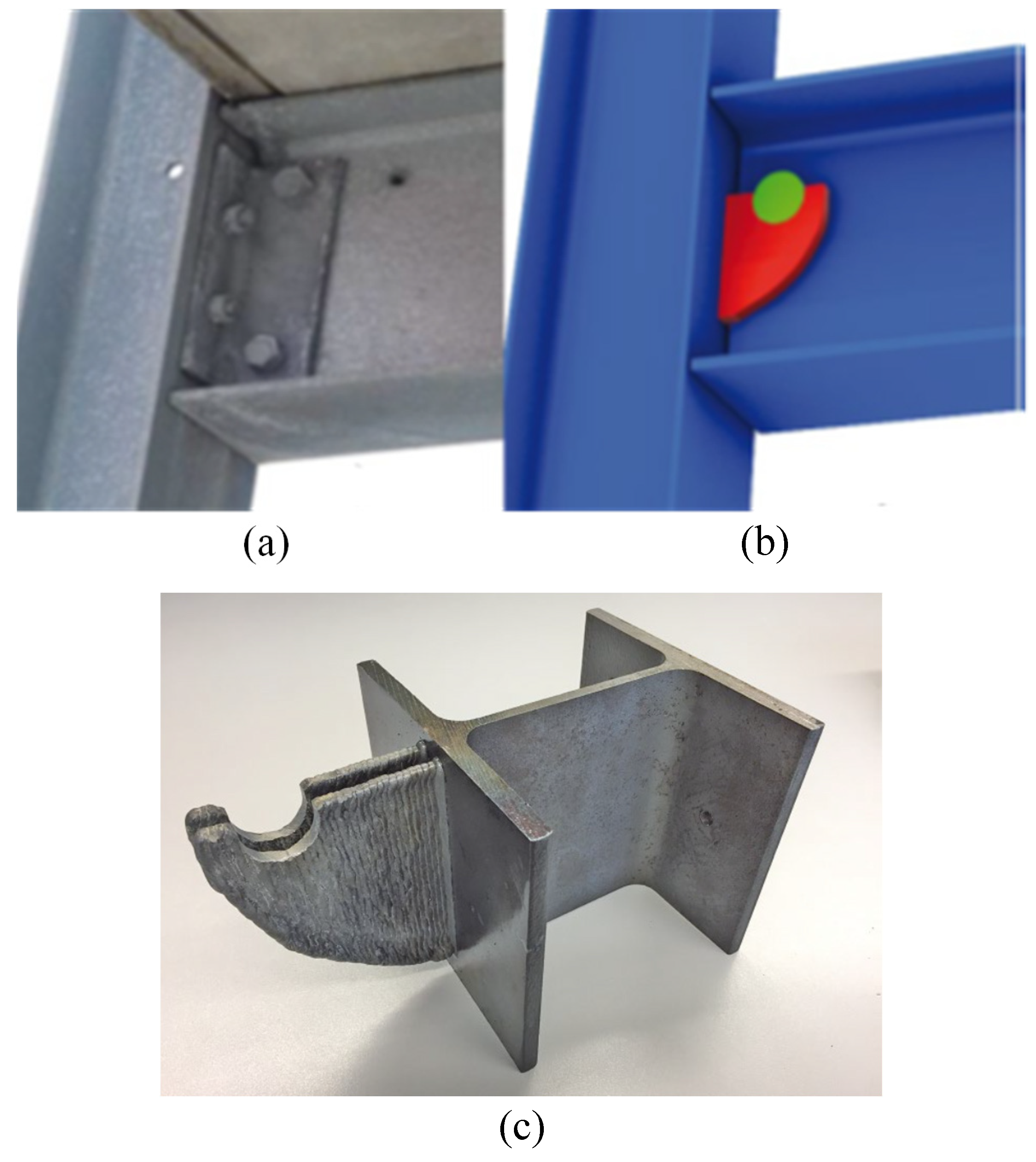

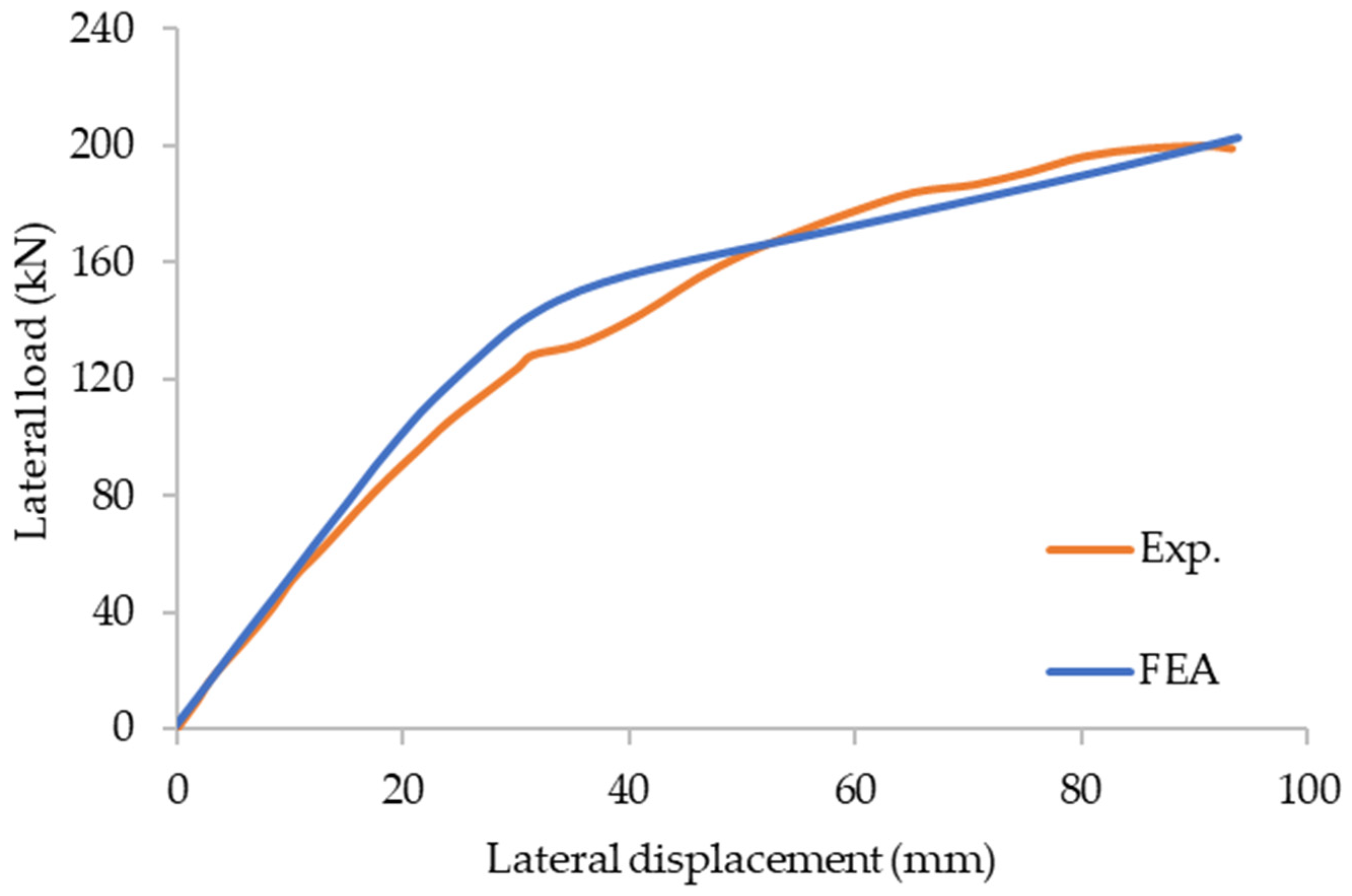


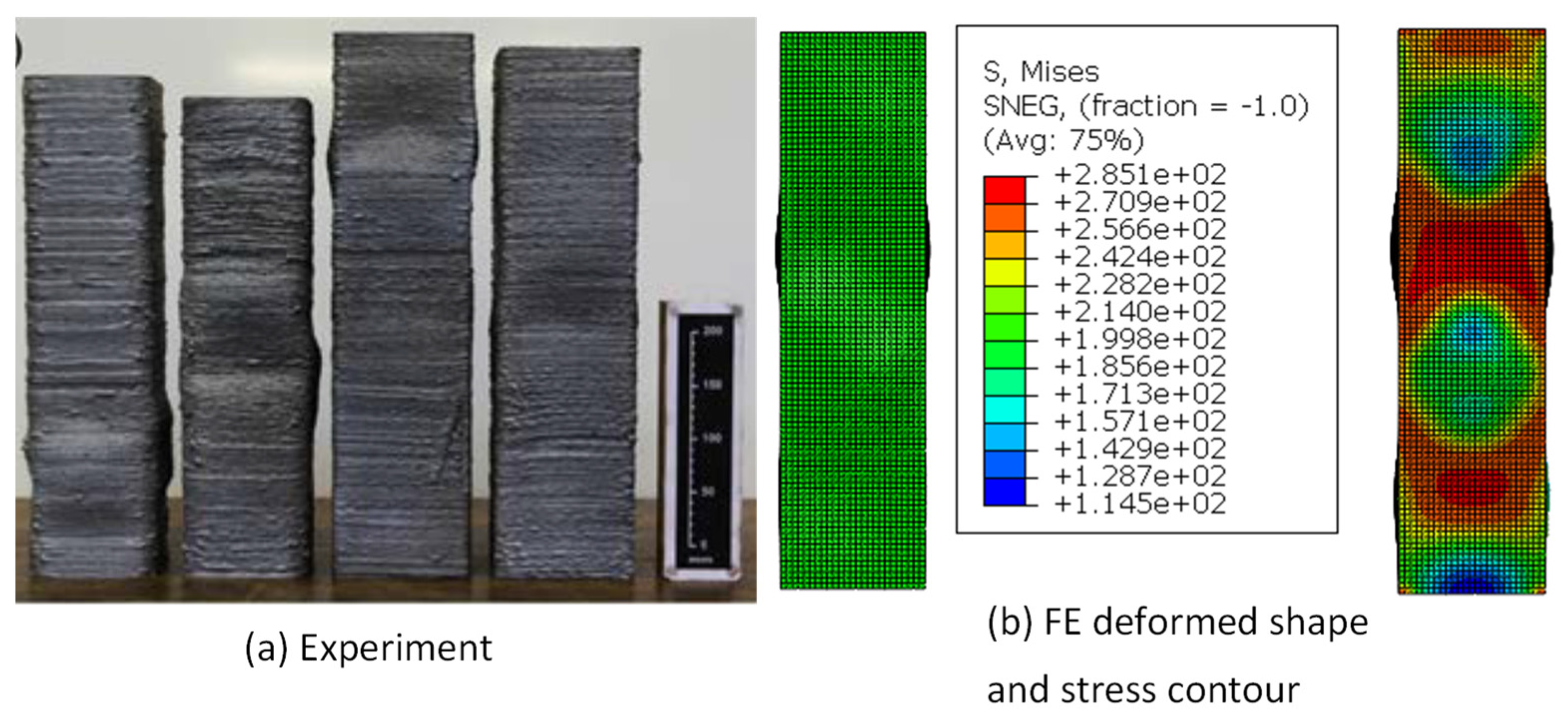
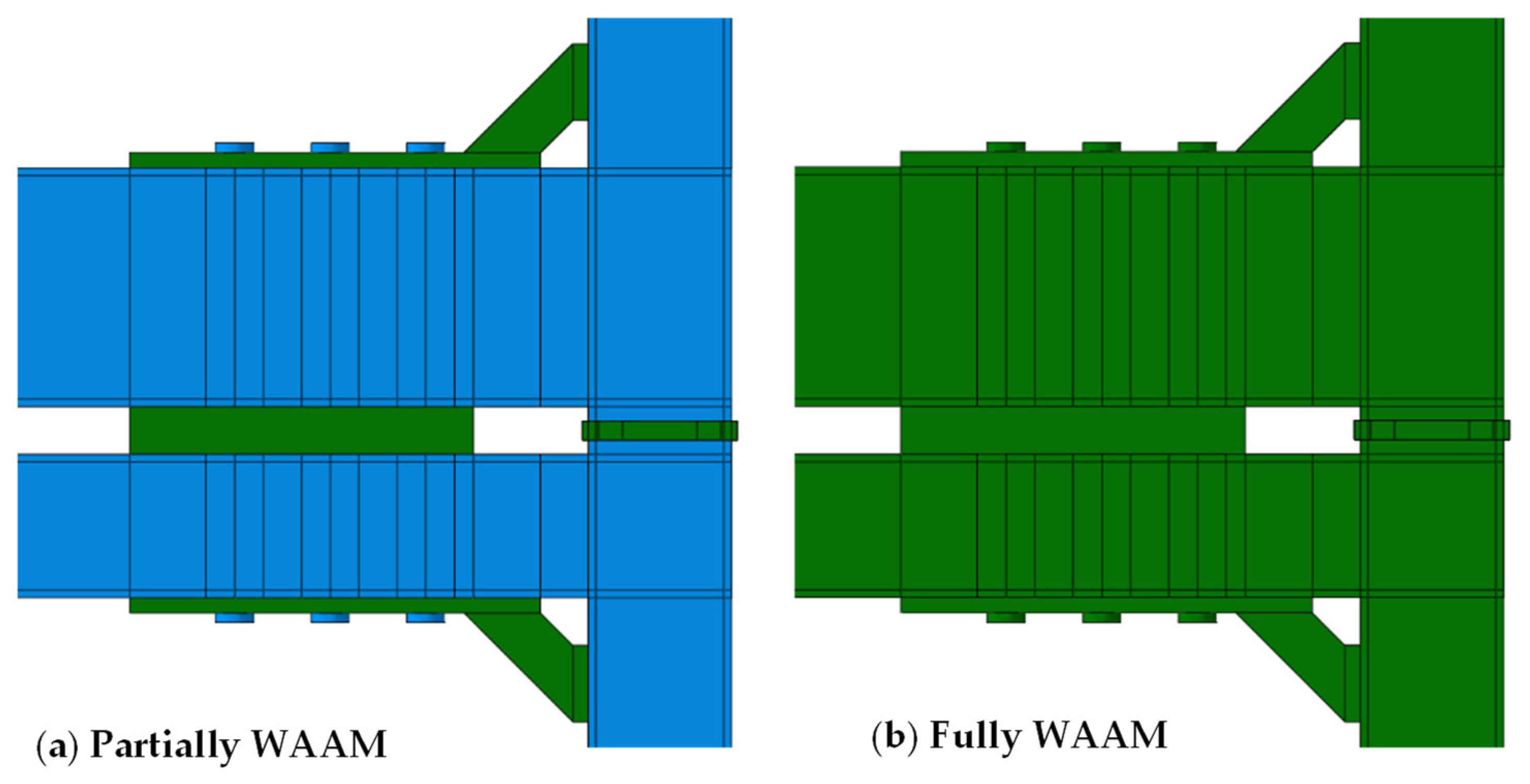
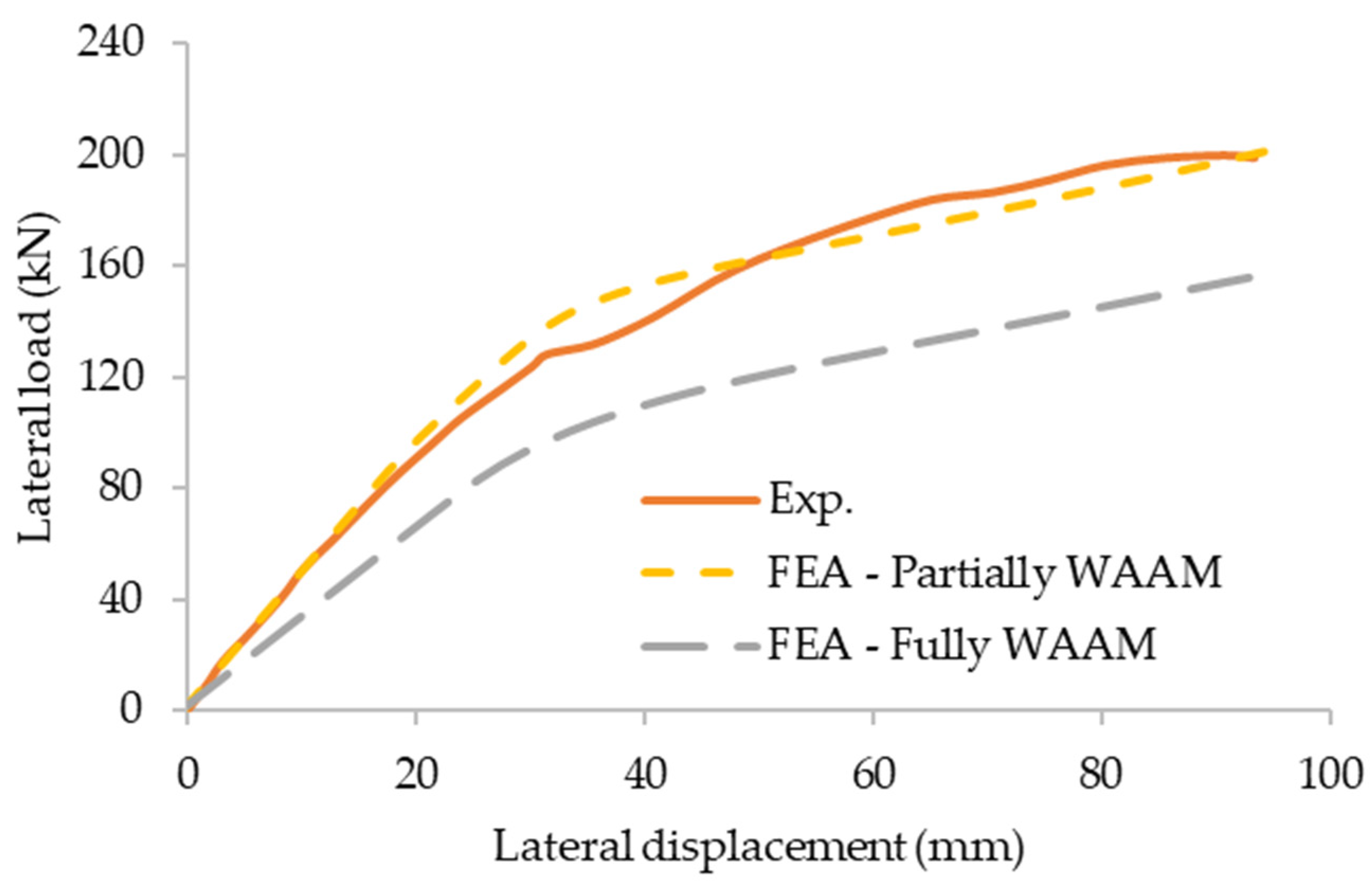

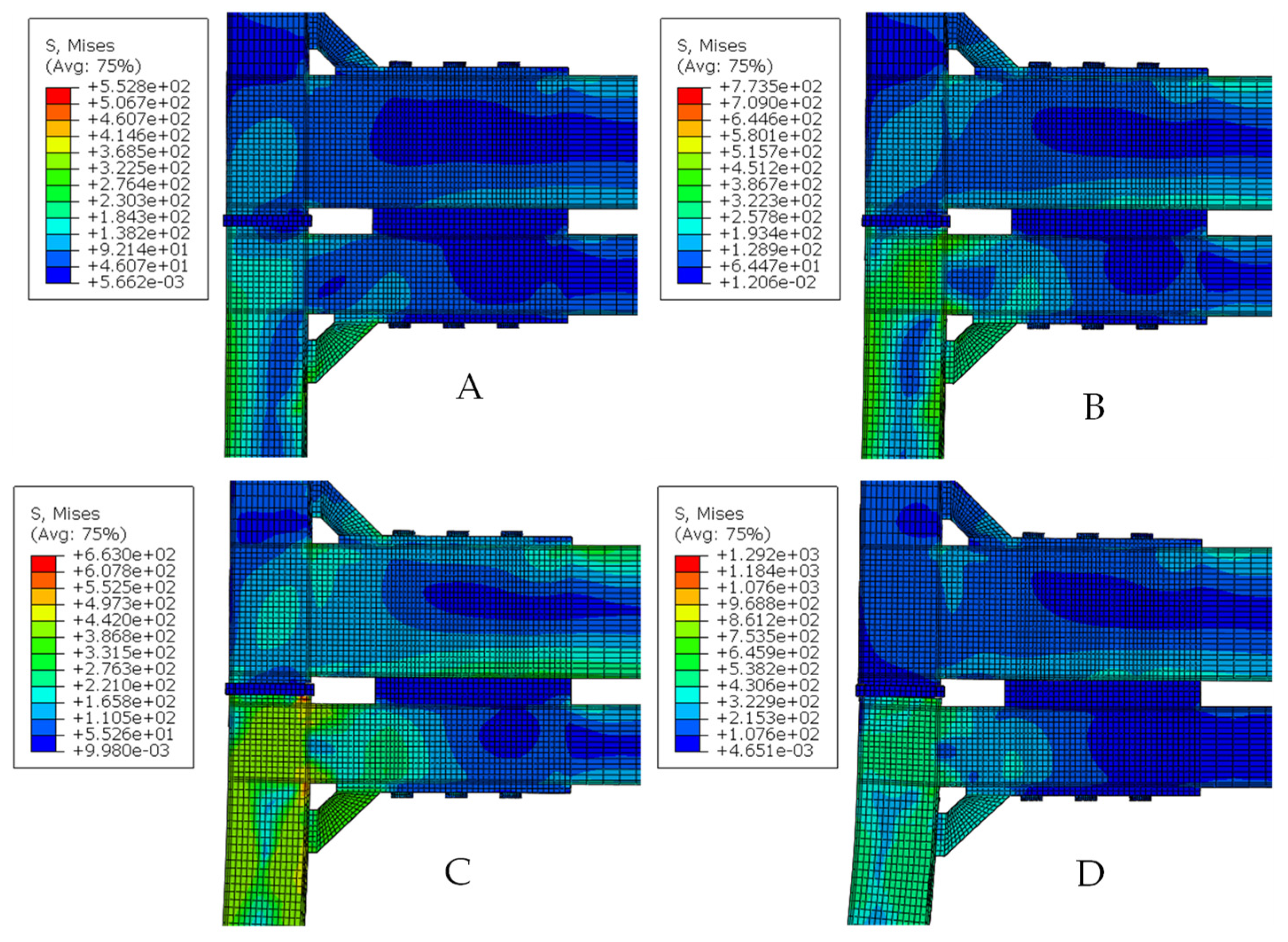
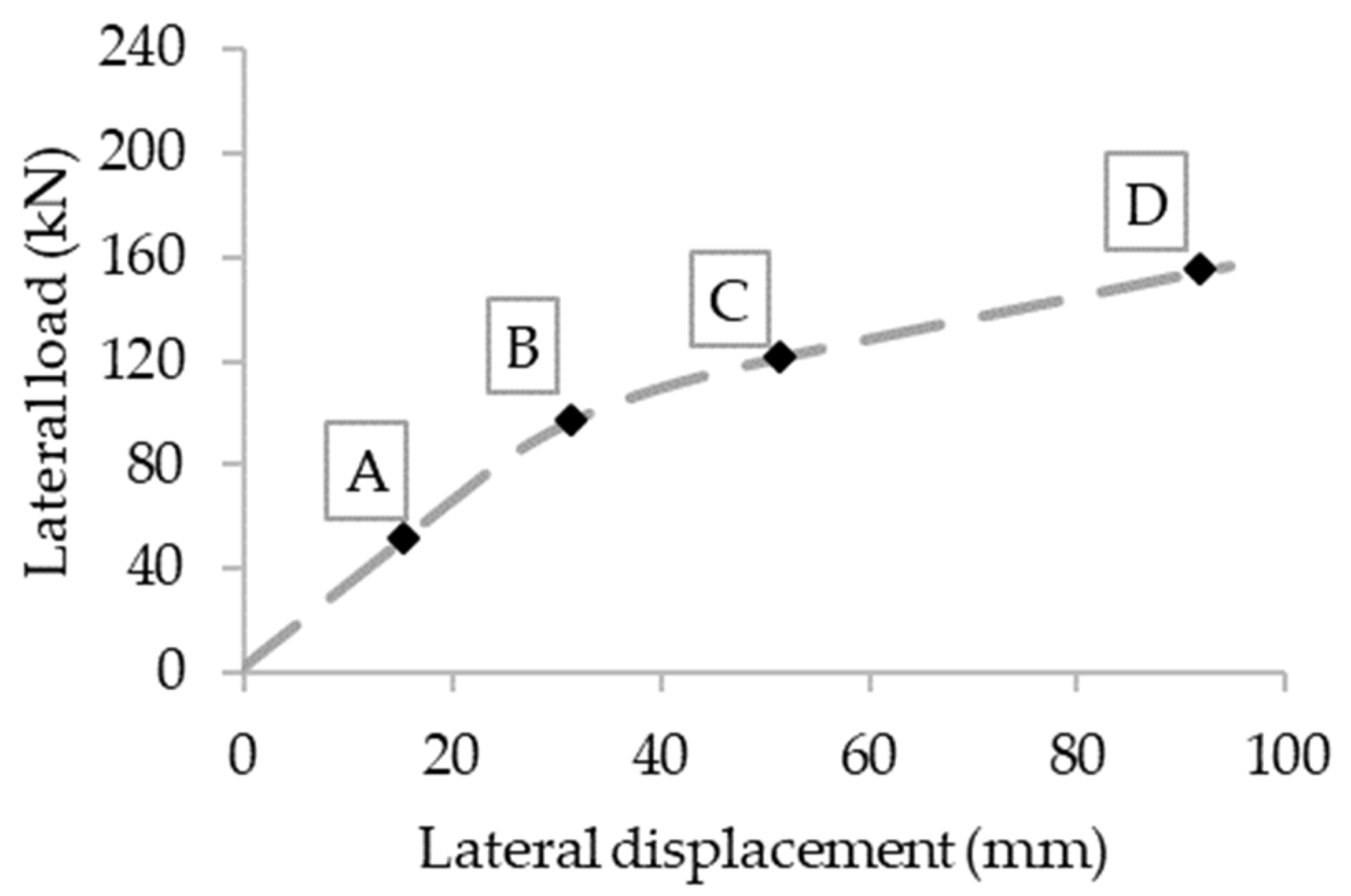
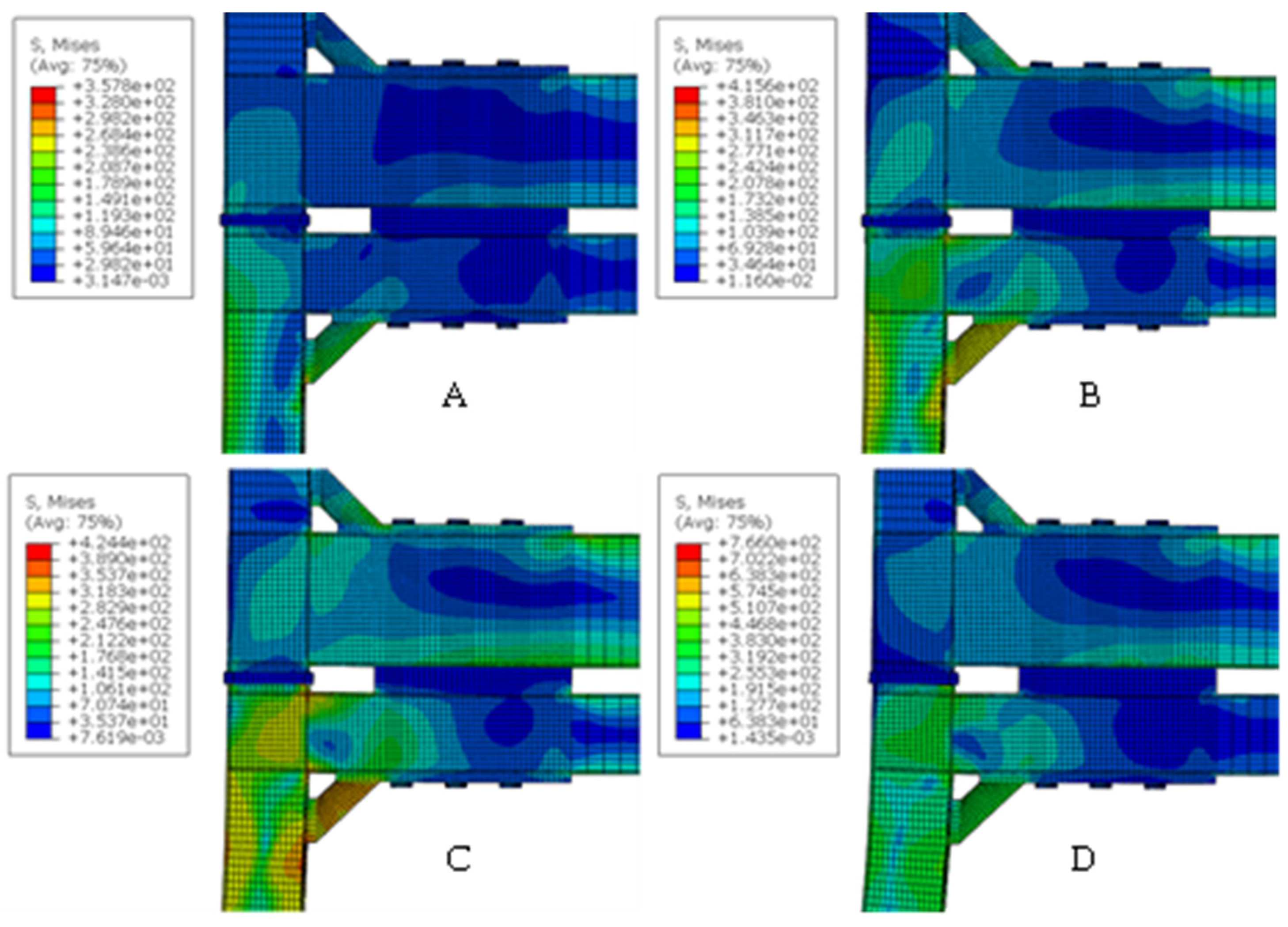

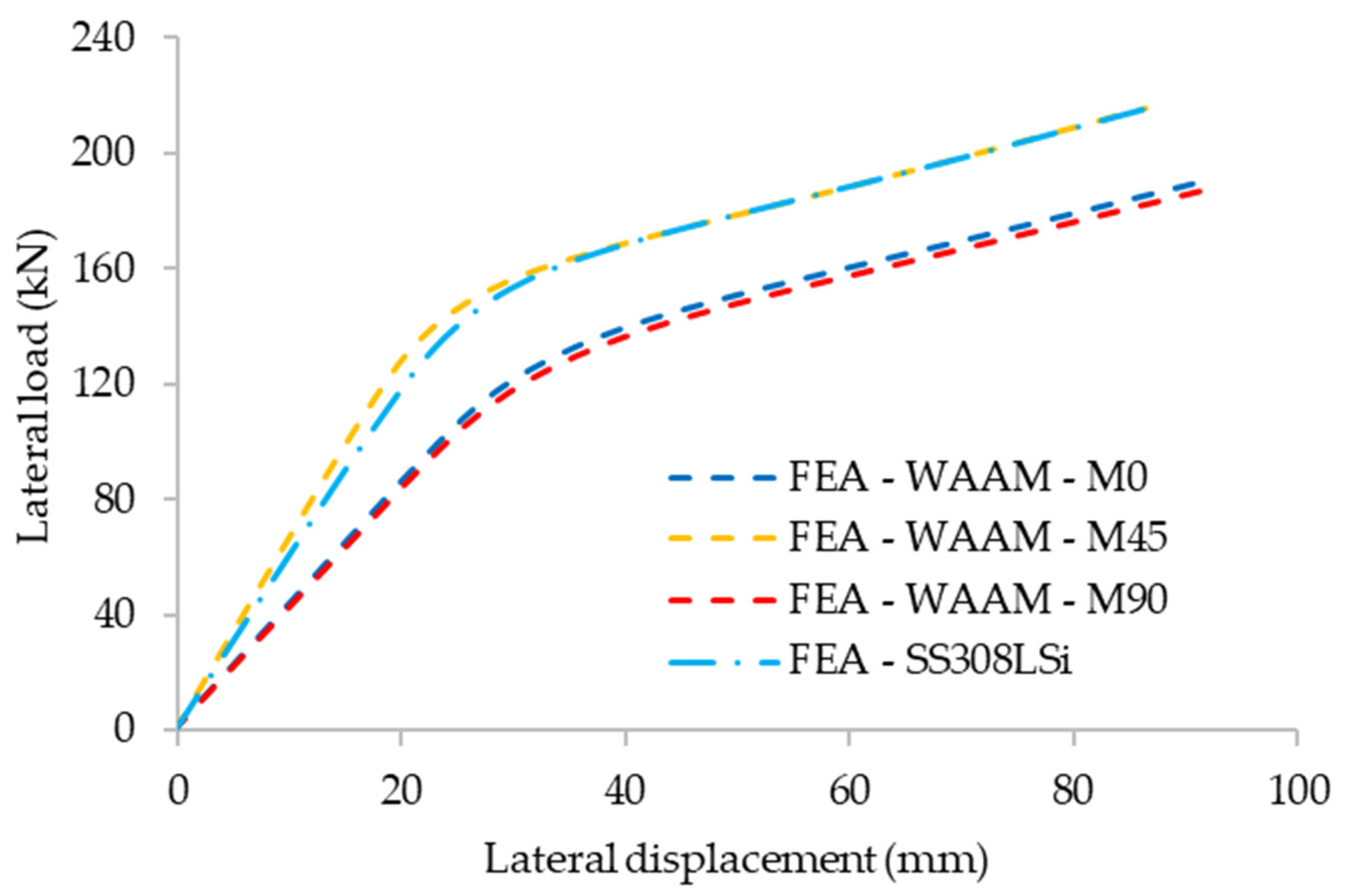
| fy (MPa) | fu (MPa) | E (MPa) | εu (%) | n | m | |
|---|---|---|---|---|---|---|
| Typical SS308LSi | 407 | 600 | 200,000 | 40.0 | 7 | 2.9 |
| Untreated WAAM (θ = 90°) [17] | 271 | 423 | 109,100 | 10.3 | 5.5 | 2.5 |
| Treated WAAM (θ = 0°) [17] | 356 | 575 | 143,000 | 30.7 | 15.8 | 2.4 |
| Treated WAAM (θ = 45°) [17] | 407 | 626 | 219,500 | 36.4 | 13.6 | 2.4 |
| Treated WAAM (θ = 90°) [17] | 338 | 554 | 139,600 | 29.7 | 6.8 | 2.7 |
Publisher’s Note: MDPI stays neutral with regard to jurisdictional claims in published maps and institutional affiliations. |
© 2021 by the authors. Licensee MDPI, Basel, Switzerland. This article is an open access article distributed under the terms and conditions of the Creative Commons Attribution (CC BY) license (https://creativecommons.org/licenses/by/4.0/).
Share and Cite
Dissanayake, M.; Suntharalingam, T.; Tsavdaridis, K.D.; Poologanathan, K.; Perampalam, G. Informed Finite Element Modelling for Wire and Arc Additively Manufactured Metallics—A Case Study on Modular Building Connections. Buildings 2022, 12, 5. https://doi.org/10.3390/buildings12010005
Dissanayake M, Suntharalingam T, Tsavdaridis KD, Poologanathan K, Perampalam G. Informed Finite Element Modelling for Wire and Arc Additively Manufactured Metallics—A Case Study on Modular Building Connections. Buildings. 2022; 12(1):5. https://doi.org/10.3390/buildings12010005
Chicago/Turabian StyleDissanayake, Madhushan, Thadshajini Suntharalingam, Konstantinos Daniel Tsavdaridis, Keerthan Poologanathan, and Gatheeshgar Perampalam. 2022. "Informed Finite Element Modelling for Wire and Arc Additively Manufactured Metallics—A Case Study on Modular Building Connections" Buildings 12, no. 1: 5. https://doi.org/10.3390/buildings12010005
APA StyleDissanayake, M., Suntharalingam, T., Tsavdaridis, K. D., Poologanathan, K., & Perampalam, G. (2022). Informed Finite Element Modelling for Wire and Arc Additively Manufactured Metallics—A Case Study on Modular Building Connections. Buildings, 12(1), 5. https://doi.org/10.3390/buildings12010005








